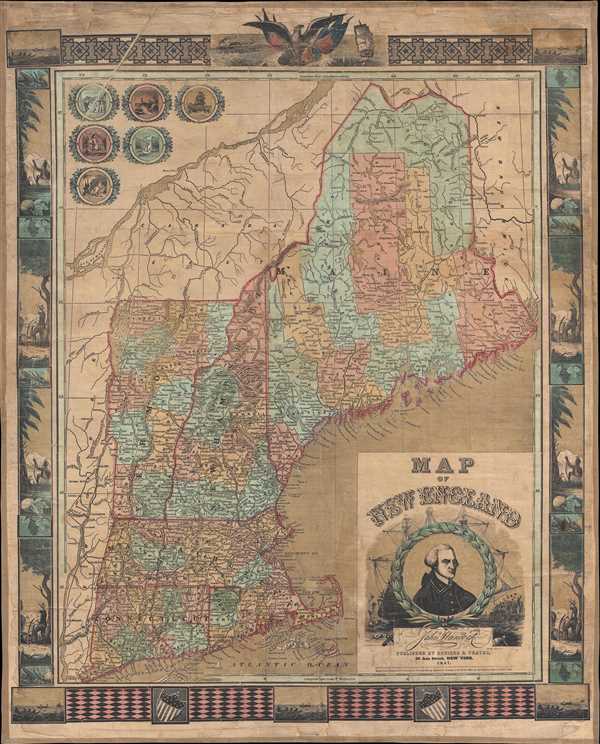
This item below is out of stock, but another example (left) is available. To view the available item, click "Details."
Details
1847 Ensigns and Thayer Decorative Map of New England
1847 (dated) $2,000.00
1847 Ensigns and Thayer Decorative Map of New England
NewEngland-ensignsthayer-1847
Title
1837 (dated) 30 x 24 in (76.2 x 60.96 cm) 1 : 1177000
Description
An elaborate title cartouche, situated in the lower right corner, bears an engraving of John Hancock, along with his famous signature on the Declaration of Independence. The scene surrounding Hancock's portrait depicts the Boston Tea Party, an event with which Hancock is associated but in which he did not take part. The engraving illustrates the Beaver, a whaleship which was the last of three ships bearing shipments of tea to arrive in Boston Harbor. On the night of December 16, 1773, colonists dressed as Indians boarded the ships in Boston Harbor and dumped over 92,000 pounds of tea into the harbor. One of these ships was the Beaver. The title cartouche, and the elaborate border work, were engraved by Lossing and Barritt, an engraving firm based in New York City.
This map was produced by Ensigns and Thayer of New York City in 1847.
CartographerS
Edward Hooker Ensign (August 18, 1818 - July 10, 1871) was an American map and print publisher based in New York during the middle part of the 19th century. Edward was born in West Hartland, Connecticut. Little is known of Ensign's training but he may have inherited his business from his father, Timothy Ensign (1795 - 1859), who was a map publisher active in New York. Ensign seems to have had a flair for partnerships and variously published with Humphrey Phelps (1799 - 1875), Horace Thayer, Thomas C. Fanning (1805 - 1873) and Erastus C. Bridgman (1817 - 1870), among others. His various imprints include 'Phelps and Ensign' (1841-1844), 'T. and E. H. Ensign' (1844-1848), 'Ensign and Thayer' (1849), 'Ensign, Thayer, and Company' (1850-1851), 'Horace Thayer and Company' (1852), and 'Ensign, Bridgman and Fanning' (1854-1863). It appears that father and son worked together for some time as well, publishing as either 'T. and E. H. Ensign' or 'Ensigns'. At least some of these companies maintained offices in both Buffalo and New York City. More by this mapmaker...
Horace Thayer (June 29, 1811 - March 15, 1875) was a New York based publisher and lithographer active in New York City and Buffalo, New York, during the middle part of the 19th century. Thayer's publications focused on travel guides, wall, and pocket maps - many of which were based on the works of other American cartographers including J. H. Colton and S. A. Mitchell. In the 1840s, he partnered with the Hartford, Connecticut publisher Timothy Ensign (1795 - 1849) and later his son, Edward Hooker Ensign (1818 - 1871). According to map historian Walter Ristow, J. H. Colton's older son, George Washington Colton, partnered with Thayer in the late 1850s and early 1860s, possibly in order to learn Thayer's lithography techniques. Certainly a number of maps emerged bearing a 'Thayer and Colton' imprint. At various points Thayer also published with other prominent publishers and printmakers, publishing as Kelloggs and Thayer (1846 - 1847), Ensigns and Thayer (1848), Ensign and Thayer (1849 - 1850), and Ensign, Thayer, and Company (1850 - 1851), Phelps and Watson (1859), and Thayer and Colton (1859-186?). Thayer seems to have moved frequently and had offices at 50 Ann Street, 156 William Street, and at 18 Beekman Street, all in New York City. Learn More...
Benson John Lossing (February 12, 1813 - June 3, 1891) was a popular and prolific American historian and a well known engraver. Benson Lossing was born in Beekman, New York. His father's ancestry can trace its roots back to the earliest Dutch settlers of the Hudson Valley and his mother, Miriam Dorland Lossing, was a Quaker. He was orphaned in 1824, and not long afterward he moved to Poughkeepsie to serve as an apprentice to Adam Henderson, who was a clock and watchmaker and a silversmith. By 1833, Lossing and Henderson had formed a partnership. In 1835, Lossing became part owner and editor of the Poughkeepsie Telegraph and also began publishing the semi-monthly literary paper the Poughkeepsie Casket. The paper's illustrator, J. A. Adams, began to teach Lossing the art of wood engraving. Seeking greater opportunity as an illustrator and journalist, Lossing moved to New York City in 1838. From 1839 to 1841, Lossing edited and illustrated Family Magazine, a weekly owned by J. S. Rothschild. His first book, Outline of the History of Fine Arts was published, beginning his illustrious career as an author. Lossing joined William Barritt in a wood engraving business in 1846, which became one of the largest firms in New York. Lossing began to contemplate writing a narrative sketchbook on the American Revolution around 1848, and the first installment was published in Harper's New Monthly Magazine in 1850. The completed work, Pictorial Field Book of the Revolution was published in 1853. Another of his major works, Pictorial Field Book of the Civil War was published in 1870. Learn More...

